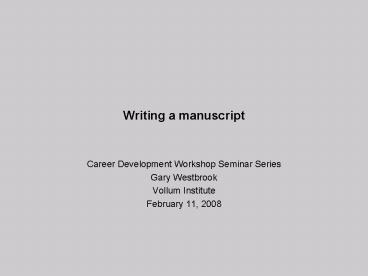Writing a manuscript - PowerPoint PPT Presentation
1 / 11
Title:
Writing a manuscript
Description:
Writing a manuscript to maximize visibility for your work. What makes a good paper? ... to Nature, your colleagues and the editors may wonder about your objectivity. ... – PowerPoint PPT presentation
Number of Views:55
Avg rating:3.0/5.0
Title: Writing a manuscript
1
Writing a manuscript
- Career Development Workshop Seminar Series
- Gary Westbrook
- Vollum Institute
- February 11, 2008
2
Writing a manuscript to maximize visibility for
your work
3
- What makes a good paper?
- Quality of the question
- Quality of the experimental design and execution
- Does it tell a story?
- Is it presented in a way that is accessible to
the general reader? - Concise, clear writing
- Learn basic grammar and English usage, but a
style book, take a course - The work should fit the Journal e.g. if you
send every manuscript to Nature, your colleagues
and the editors may wonder about your
objectivity.
4
- Abstract
- It should give the reason why the work was done
and the main findings. Remember most people never
read your paper, if you are lucky they will read
the abstract. - Sentences such as The significance for
Alzheimers disease will be discussed are
worthless. If there is no conclusion, maybe you
need to do more experiments. - Depending on the journal, the reader should be
able to understand the type of experiment that
was performed from the abstract
(electrophysiology, protein biochemistry,
behavioral analysis, etc.) - Highly speculative conclusions are risky. Your
credibility is as important as getting the work
published.
5
- Introduction
- The purpose of an introduction is to give the
specific rationale and background for these
experiments. - An extensive literature review is not
appropriate. - The scope of the introduction should fit the
content of the work. For example, an extensive
discussion of the cost of Alzheimers disease to
society is not appropriate for a paper on
b-amyloid toxicity in cell cultures. - Write only as much as needed. Some papers will
need only very brief introduction, while others
may require more explanatory material. - Avoid tired phrases such as Glutamate is the
major excitatory transmitter in the brain.
Start with an idea that is specifically
applicable to your work. - Do not reiterate the same points (or phrases)
that were made in the abstract or will be
discussed in the discussion.
6
- Results and Figures
- Put the overall results in the text. The
description of the specific example in the figure
should be in the figure legend. - Use only as many figures as needed.
- Size the figures appropriately with readable
legends. - Design figures so that they can be understood
almost without looking at the text or legend if
the reader is knowledgeable in the field. - Avoid using the same figure layout for multiple
figures. For example, 12 figures with multiple
histograms is visually boring.
7
- Supplementary figures
- Data essential to the paper should go in the
manuscript, not the supplement - If you have more supplementary figures than
figures, you may be sending the paper to a
magazine instead of a journal! - Legitimate supplementary figures should be
supplemental, I.e. primarily of interest to a
specialist or an illustration of a control that
could be stated in a sentence in the text. - As a reader, remember that supplementary
information is rarely reviewed with the same
rigor as the manuscript itsel - Avoid using the same figure layout for multiple
figures. For example, 12 figures with multiple
histograms is visually boring.
8
- Discussion
- AVOID reiteration of the results
- Do not walk through discussion points in the same
order as the figures were presented - Pick several topics (e.g. 3) that you think are
specifically addressed by the work and discuss
those, e.g. - Comparison to prior results
- Discussion of finding A
- Discussion of finding B
- Significance at another level e.g. to disease,
to system or - network function, etc.
- Keep the speculation to a minimum and save for
the later parts of the discussion
9
- Dealing with Editors
- Be courteous and straightforward, but dont be
shy about making your point. - Follow the Instructions for Authors
- Dont try to oversell the message of the paper in
the cover letter - Assume the editor is an intelligent scientist
(until proven otherwise) - Dont distort the comments of the reviewers in a
rebuttal letter. It will backfire when the
editor looks at the revised manuscript and the
reviewers comments. - Think about what you have to say before you call
or write an editor. Writing it down and editing a
letter is much more effective, than a hasty
e-mail dashed off minutes after receiving the
reviews. - Insults and letters filled with CAPITAL LETTERS,
bold letters and EXCLAMATION POINTS!!! are not
likely to get you where you want to go.
10
(No Transcript)
11
Picking a journal
- Assess the scope of your work, the potential
audience, and the style of each journal - Presubmission inquiries? - OK if you really have
a question, but not a good strategy to grease the
path - A high average impact factor for a journal does
not make your paper a good paper, or a highly
cited paper (see skew distribution below) - If you really care about citations for your
paper, theres always GoogleScholar
From Colquhoun, Nature, 2003

